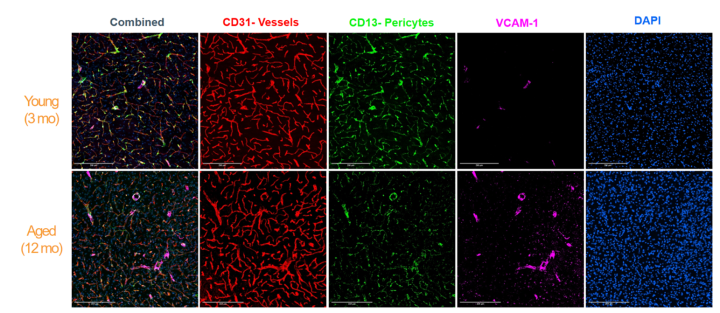Daniela (Dany) Jaime Garcia - Prize winner and her current research
Dany Jaime Garcia conjointly wins prize for best talk at the UK DRI ECR vascular theme meeting in York
We are pleased to congratulate Dany Jaime Garcia on winning a prize for her talk, "From animals to humans: investigating the role of pericytes and endothelial cells in small vessel disease (SVD) through a translational perspective" at the ECR Vascular theme meeting held by the UK DRI in York on 14-15 May.
Dany is a Wellcome Trust PhD Student and Research Assistant in Clinical Studies of Small Vessel Disease based within the Row Fogo Centre and we're lucky to have her as part of the team. Dany has shared an overview of her current work and what for her makes SVD research so important:
Introduction

I’m Dany, a third-year PhD student from Mexico in the Wellcome Trust Translational Neuroscience programme. Currently, I’m collaborating with Dr Axel Montagne and Professor Joanna Wardlaw on a series of research projects aimed at gaining a deeper understanding of the causes of small vessel disease (SVD).
As a neuroscientist, I have always placed great importance on approaching my work from a translational perspective. My journey started with undergraduate degrees in neuroscience and psychology, followed by hands-on experience assisting patients in their rehabilitation from stroke and traumatic brain injury. Subsequently, I pursued a clinically-focussed master’s degree in Stroke Medicine at the Queen Square Institute of Neurology at University College London. Shortly after, I joined Professor Joanna Wardlaw’s team at the University of Edinburgh, working on several clinical studies of SVD. I am now continuing my involvement in these clinical studies whilst also working towards my PhD, incorporating laboratory research to complement our investigations.
Context – why is SVD research important?
SVD is a highly prevalent disorder of the brain’s perforating microvessels. It is the underlying cause of a quarter of all ischaemic strokes and most haemorrhagic strokes and is the commonest cause of vascular dementia, contributing to approximately 45% of all dementias worldwide. Despite its increasing incidence and importance in the public health domain, the underlying pathophysiology of SVD remains poorly understood and there is currently no effective therapeutic intervention beyond secondary stroke-prevention strategies.
Understanding the causes and downstream consequences of SVD is essential for the progress of therapeutic interventions. We believe that a critical milestone in the development of disease mechanisms lies in the malfunction of brain endothelial cells and the pericytes that support them in vital functions related to cerebrovascular operations, such as regulating blood flow and preserving the integrity of the blood-brain barrier (BBB).
Approach
An important risk factor for SVD is the ageing process. Therefore, our initial inquiry revolved around the effects of normal ageing on brain endothelial cells and the capillary-enwrapping pericytes. Our findings indicate that, in comparison to young mice, aged mice exhibit a notable decrease in pericyte coverage in brain capillaries, approximately 8%. Additionally, the endothelial cells in aged mice demonstrate notably higher levels of VCAM-1 expression, which is a marker signifying endothelial dysfunction and activation, often linked with the breakdown of the BBB (Figure 1).

Subsequently, we wondered whether these findings would translate to a human SVD population. Through a collaborative effort with Colin Smith, Karina McDade and Justyna Cholewa-Waclaw, we conducted a comparative analysis of pericyte coverage and endothelial activation in post-mortem brain tissue samples from young, healthy individuals and elderly patients with varying degrees of SVD severity. Our observations revealed that, in comparison to the young control group, aged individuals with severe SVD exhibited a significant 30% reduction in pericyte coverage and a 40% increase in VCAM-1 expression (Figure 2).

Currently, I am working on a clinical biomarker project focussing on the relationship between blood markers of endothelial and pericyte dysfunction and various longitudinal outcomes concerning the progression of SVD using data from the longitudinal neuroimaging study, The Mild Stroke Study 3 (MSS3). Over the course of the past five years, I have been involved in various aspects of this study, and it has been an exceptional privilege to then be able to incorporate these data into my PhD project. I am concurrently engaged in other ongoing projects, including an examination of nine-year longitudinal outcomes of mild stroke and SVD, as well as pre-clinical investigations aimed at unravelling the intricacies of endothelial dysfunction and the breakdown of the blood-brain barrier.
Although this journey comes with its share of challenges, I consider myself remarkably fortunate to have the opportunity to explore both the clinical and pre-clinical facets of research while I strive to address these questions. The invaluable support and inspiration from my supervisors and peers have certainly been instrumental along the way.


